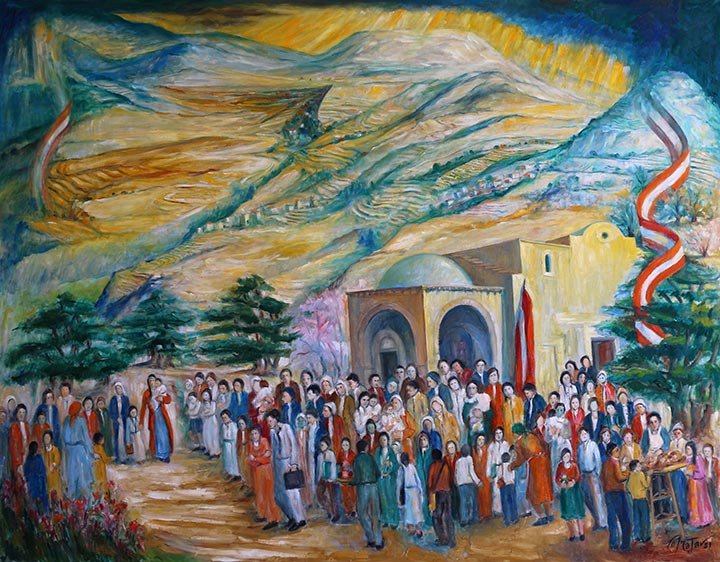Sacred Mountains and Spring by artist-painter Joseph Matar
1- Pastoral intimacy
In this contemporary world, the pace of our activities is becoming dizzying. Stopping is forbidden, and development must always progress. This applies in many areas, but when it comes to art, culture, thought, resting the soul, halting, and meditation are necessary. It’s like the sabbatical year in history; currently in university programs, stopping to change activity is no longer stagnating in place, at the same level.
The 7th day, which is assumed was designed for rest, is a 7th day full of brain activity, creativity, and construction because the created artwork must exist in the soul and spirit of the artist before shaping into a material body, a palpable, visible presence, a canvas, a sculpture, the written idea etc…
It is true; the creator manifests himself in his artwork. It exists everywhere, in every line, shape, touch… in all the shades of the colored range. The artwork is addressed to all beings, to all those who look at it in order to dissect it, assimilate it, analyze it … The artwork is a mirror of the soul, a prayer, a communion with creation. Where does an artwork begin? And where does it end? Or maybe the artworks remain always unfinished? You can always push the study deeper. Giving a name to an artwork makes sense, but it is not necessary. The same artwork can have several dimensions or several names. The true identity of the artwork is the artist himself, it bears his name, and the work begins in his soul.
We can say, this artwork is the Mona Lisa or: it is Leonardo; it’s the Night Watch, or it’s Rembrandt.
2- The artwork, object of this study is a painting on canvas measuring 160×200 cm
A composition where several elements come into play. The human being, the cedars, the flag … and other secondary elements, the mountains, the church, leaving the cathedral after baptism, a day of celebration, etc…
Several preparatory studies were carried out, this lasted several months.
A large crowd gathered to the right side of the painting welcoming a woman with two children framed by several cedars, the Lebanese flag which crisscrosses the entire artwork like a rainbow in the firmament. The legendary, mythological mountains. The summit “Saouda’s peak” or the martyrs, the crest of Mount Aytou, comes next, the most beautiful summit of Mount Lebanon, Sannine, and other wonders like the Biblical Mount “Hermon”. The three highest peaks in this Middle East.
A few details to bring out the picturesque… The hamlets, hanging terraces, which follow one another, the rays of light falling like rain from a dark sky… In the foreground, the baptistery, the crowd awaiting an event, the arrival of someone, a speech, a song, a poem… A common prayer…
The spaces of light and shade are intelligently distributed and give the painting its privacy. Three cedars on the left, form a rampart like the defense of a fortress, a force, defying eternity. The colorful, rich, solid matter emanating from the light. This mystical light that springs from the soul of the artist-poet Joseph Matar. The material, sometimes thick, sometimes light and transparent, flows from its heart, like the tears in the eyes of a loving and passionate couple. No chatter, between the real and the true, it is the truth that prevails like the values. The artist expresses himself, dialogues with his heart a language of friendship, love, prayer. The real tools, the artist’s materials, are his soul, his thought, his feelings, his whole being… They are essential to realize the painting such as the colors, the mines, the shapes, the palette… Hundreds of studies, in lead mines, sepia, watercolor, studying all the construction and infrastructure of the painting, tests, research, everything leads to Rome. Studies repeated several times in other forms, finally, it is the two-meter artwork that is erected.
The conscious and the unconscious complement each other, the feelings join in this effort, with the sensitivity, the techniques, and the knowledge, the love, the ability, the willing, are metamorphosed on this empty surface, and whitish in a living flame which addresses itself in emotion to the one who observes it.
Jean de Lalande
Adaptation by Mayda Samaha



